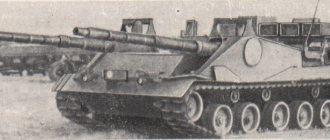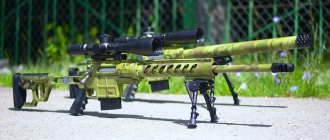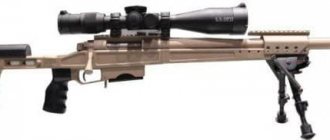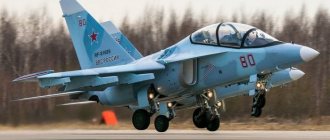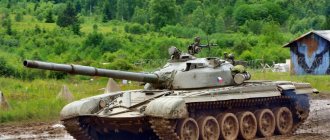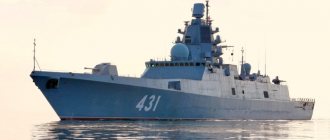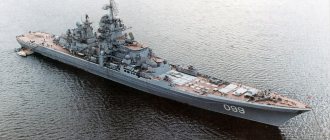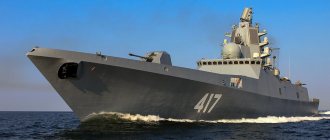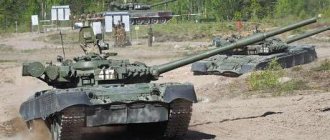The classification of tanks has changed the terminology several times throughout the history of their use. One such term is main battle tank, which refers to a multi-purpose vehicle that combines high striking power, mobility and armor. It is this type of equipment that becomes the basis of tank formations in large-scale operations.
In the Russian classification, two terms are known - main tank and special. The first type coincides with Western classifications. A special vehicle is a single-purpose vehicle used for specific types of troops or tasks.
“Black Eagle” is a Russian main tank project developed in the 1990s by the Omsk Transport Engineering Design Bureau. Also known as "Object 640". It was assembled only as a prototype and was not released into mass production.
History of creation
Model of the “Black Eagle”
The development of the “Black Eagle” tank was carried out in conditions of increased secrecy. There is no exact information about the start of work on the project; according to some sources, it has been carried out since the late 1980s. The first demonstration took place in 1997, but the performance characteristics of the tank were not disclosed, and the tank itself was demonstrated at a distance, hiding its turret with a camouflage net.
The prototype was shown again in 1999, but information about it was also hidden. This did not stop the media and ordinary observers from building theories about the exclusivity of the new technology. In the early 2000s, the creation of a new T-95 was announced, which many associated with the ob. 640.
American self-propelled gun of World War II
The T-28 "Turtle", called the T-95 - PT-SAU, is an American prototype self-propelled artillery mount, created during the Second World War and is a tank destroyer. Some historians classify this model as a super-heavy tank. This self-propelled gun had been designed since 1943, but by the end of the war its serial production had not started. The only thing the designers managed to do was produce two prototypes in 1945-1946. In terms of weight, the T-95 tank (tank destroyer) is second only to the German Maus.
Why did work on the prototype stop?
After 1999, the Black Eagle tank was no longer publicly displayed. No one announced its acceptance either. Due to the lack of orders from the Ministry of Defense, the Omsk plant went bankrupt in 2005. It is this aspect that is considered the reason for the cessation of development.
In 2009, an official statement from the Ministry of Defense appeared that the Black Eagle tank does not exist. All developments in this direction were aimed at creating the “Armata”, which is why “Object 640” is considered one of its predecessors.
Power point
The designers equipped the Object 195 tank with the Chelyabinsk V-92S2F2 diesel engine. This is a temporary measure; the power plant does not meet modern requirements. Power is only 1130 hp. pp., the mobility of the promising tank is slightly higher than that of the main combat vehicle of the previous generation. A 12N360T-90A diesel engine is expected to be installed as a standard unit. The engine is four-stroke, X-shaped, 12-cylinder, with gas turbine supercharging and intermediate air cooling. Liquid cooling system. Working volume – 34.6 l. Power of at least 1650 hp. With. provides a combat vehicle with a thrust-to-weight ratio of at least 30 hp. With. per ton. The engine is located along the combat vehicle and is coupled with an automatic transmission.
Description of design
Side and top view
The development of the Black Eagle tank was based on the concept of using this technology in local conflicts. According to the developers, it is due to a decrease in the likelihood of large-scale combat operations with the advance of large tank units.
Taking this aspect into account, a modern tank must have good transportability for transfer to a given region, combine maneuverability and rapid deployment. The main problem for this was the need to reduce weight due to the armor and turret, which affected the survivability of the tank.
The design of the Black Eagle tank includes a tracked undercarriage, a hull with a control compartment and an engine-transmission compartment, a chase turret, an armament complex with ammunition and armor.
A special feature of the body of this vehicle is the presence of armored partitions dividing it into three compartments. The entire crew is located below the tower level in the habitable compartment. The seats are adjustable, there is a traveling position and a combat position. To leave the vehicle, each crew member has his own hatch - in the hull for the driver and two in the turret for the commander and gunner.
Department of Management
The control compartment is located at the front in accordance with the classic layout. The key difference is the division into three compartments. The driver occupies the middle position; on either side of him behind armored partitions there are fuel tanks. The design reliably protects the crew from their explosion.
Combat compartment
The fighting compartment also has a non-standard layout. The gunner's and commander's positions are located in the middle part, in the combat position no higher than the turret shoulder strap. The crew is protected from the explosion of ammunition and the removal of powder gases. Loading the gun is automated.
Tower
The Black Eagle turret is its most recognizable part.
The design of the turret provides all-round protection from shells, and also takes into account the possibility of being hit from above. Because of this, the tower is reduced in size and divided into two compartments. The front part has an angle of 20-30 degrees, which reduces the likelihood of damage.
Taking into account the dimensions and layout of the turret, its protection has been increased by 1.7-2 times with directional fire of 35-40 degrees. The total weight has been increased to only 30%, which is considered the optimal combination to ensure the survivability of the tank.
Protection against damage from above ensures that the turret is resistant to targeted parachute cluster projectiles. The armor can also withstand attacks from anti-tank missile systems such as Bill-2 and Javelin.
Levels of protection
To maintain the transportability of a tank, its optimal weight is considered to be up to 50 tons. This figure is often achieved by reducing the ammunition load and armor protection, which ultimately affects the combat capabilities and survivability of the vehicle.
"Black Eagle" has three levels of protection:
- traditional armor is considered the key passive defense of a tank, protecting its hull and turret;
- active destruction of projectiles;
- radar detection and suppression of enemy assets.
The tank's armor is traditionally differentiated. The greatest protection is on the front and nose sheets, less on the sides. At the same time, the side armor also increases in the bow. Vertical armor plates to protect the crew are made with anti-fragmentation and anti-radiation lining.
The second level includes active dynamic protection with firing elements of the Drozd-2 type. Such a system detects and engages projectiles at a distance, excluding hits on the vehicle.
For this purpose, the hull is equipped with mortars, each with its own firing sector. Damage radii overlap and allow projectiles to be fired around the entire circumference. Detection is provided by a radar system, the control unit of which is located at the commander and gunner.
The third level of protection is a set of Shtora-type devices, designed to detect and suppress enemy electronic devices. Valid at a distance of up to 5 km. Additionally, the release of aerosol grenades is provided to create interference.
The general operation of protection systems implies the following scheme:
- the Shtora radar complex detects enemy surveillance equipment or laser irradiation for the purpose of guiding a projectile;
- the crew is informed about the attack, automatic or command launch of an aerosol grenade is allowed;
- the aerosol disrupts auto-guidance, complicates the search for a target with guided ammunition and the operation of anti-tank systems;
- if a projectile is launched, the Drozd system comes into effect, the target is detected and hit by a fragmentation field at a distance safe for the tank;
- the last level is tank armor, including mounted units with dynamic protection.
If the armor is penetrated, crew survivability is ensured by the tank's layout and internal armor plates. The energy of the explosion is directed upwards and to the sides; for this there are special ejection hatches. Crew protection is also provided in the event of an explosion of ammunition or fuel tanks.
In the late eighties, our engineers looked into the future
The design of a new type of combat vehicle began in 1988. The main idea was to increase the survivability of the crew and the ability to modernize weapons systems without radical modifications to the vehicle. To satisfy this requirement, it was proposed to make the tower uninhabited. That is, automatic equipment had to aim the gun or small arms at the target, select the type of ammunition and fire the shot. The crew itself should have been placed in an isolated, well-protected armored capsule. It was supposed to be a tank with a completely new layout and powerful protection. The political upheavals of the last decade of the last century did not allow us to fully realize our plans. And the level of development of electronics at that time would hardly have made it possible to create a highly effective combat system. This concept was embodied in metal a few years later by Ural tank builders creating the Object 195. Photos of a tank covered with a tarpaulin cannot help to get an idea of the design of an autonomous artillery mount.
Tank armament
The machine gun is easily removable for ease of transportation.
The basic armament of the Black Eagle tank is represented by the following aspects:
- 125 mm smoothbore gun with 32 rounds of ammunition;
- two machine guns - PKT 7.62 mm and Kord 12.7 mm;
- grenade launchers to create a smoke screen.
The design of the tank provided for the possibility of replacing the gun with a larger one, up to 152 mm. The cannon, machine guns and grenade launcher were controlled automatically. At the same time, the gunner and commander had equal access to weapons.
The automated loading mechanism is one of the key features of the tank. Developments in this direction were also carried out in other countries, the main problem was the detonation of ammunition in the event of a hit by a cumulative projectile.
This led to the loss of the crew and the tank, which is why Western vehicles, for example Leopard-2, Abrams, abandoned automated loading. For them, this functionality is provided by the fourth crew member - the loader.
The Black Eagle tank has its ammunition removed from the outside. The shells are stacked horizontally in an armored removable module located behind the turret above the engine and transmission compartment. Their position is oriented along the axis of the gun; they communicate with the breech only at the moment of loading.
Use of self-propelled guns
Self-propelled guns have a powerful long-range weapon capable of hitting the enemy at considerable distances, so there is no point in getting close to the enemy. Self-propelled guns do not have powerful protection, since they must fire not at the front line, but from the rear of the main troops. Roughly speaking, self-propelled guns are powerful long-range artillery, capable of quickly independently changing their position after firing. However, since the beginning of World War II, these armored vehicles have been used not only in the form of heavy howitzers, but also as assault guns, supporting attacking troops with their fire, as well as tank destroyers, capable of hunting and destroying enemy armored vehicles from both close and long range.
Specifications
Transporting the “Black Eagle” for display
The characteristics of the “Black Eagle” tank remained unknown for a long time and managed to acquire a number of myths. However, the available data confirms the competitiveness of the machine with Western analogues of the latest generations. In this regard, the developers were able to find the optimal combination of layout, which, in accordance with a given concept, provides the tank with survivability, combat power and the ability to effectively participate in local conflicts.
Dimensions and weight
In terms of dimensions and weight, the tank has the following indicators:
- body length - 7.97 m;
- width - 3.095 m;
- height - 1.793;
- ground clearance - 0.5 m;
- combat weight - 48 tons.
Due to the reduced dimensions of the turret, the Black Eagle is considered one of the lowest tanks. This aspect does not reduce its cross-country ability. The vehicle is capable of overcoming walls 0.8 m wide and ditches 2.8 m wide. With underwater tank driving equipment (OPVT), the Black Eagle is capable of diving to a depth of up to 5 m.
Crew
The crew of object 640 is 3 people: driver, commander and gunner. The first is located in the control compartment, the rest are in the fighting compartment connected to it under the turret.
Engine and chassis
The Black Eagle tank is equipped with a 1,500 hp gas turbine engine. With. This increased the specific power of the machine to 30.25 hp. s./t, which was superior to Western analogues with their 20-25 liters. s./t. The first version of the tank had a modified T-80U chassis with a turret mounted on it.
The undercarriage is caterpillar, seven-support, with torsion bar suspension. There are removable extensions on the tracks that reduce the ground pressure to 0.8-0.81 kg per square centimeter. Removing the extensions allows the tank to be transported on railway platforms.
It is also allowed to install part of the extensions only on the inside. This helps to meet the railway standard in terms of dimensions and enter into battle immediately from the platform.
Top speed and tank
The maximum speed on the highway is up to 80 km/h. The cruising range without additional mounted tanks is 500 km, with them the distance doubles. There is no exact data on the volume of fuel tanks. The given range is calculated on the highway; on rough terrain it will be lower.
Controls
The main control element of the vehicle is the multifunctional remote control, available to both the gunner and the commander. All systems are integrated and allow weapons to be controlled from any of these locations. The complex system also includes:
- sight control panels;
- ballistic computers;
- weapon stabilizers;
- loading complexes.
If necessary, the tank can be equipped with control systems for additional weapons. The complex is designed for several operating modes - main, semi-automatic, automatic, target designation and manual.
Results
The result of the review of the Turtle self-propelled guns shows us that each type of armored vehicle must correspond to its time.
According to its characteristics, the American T-95 was an excellent vehicle before the start of World War II, but with the development of weapons, it fell catastrophically behind the main types of armored and artillery forces not only of its allies, but also of potential opponents. It was not economically profitable to continue working on the backward project, so it was closed.
Studying the negative experience of past years, modern designers of military equipment are trying to design weapons in such a way that they meet the requirements of war and fulfill assigned combat missions to the maximum extent possible.
Advantages and disadvantages
Aft
The advantages of the experimental tank include:
- good driving performance;
- comprehensive three-level machine protection;
- protection of the crew from projectiles and explosions;
- automated gun loading.
In addition to these qualities, the tank is repairable. Most aspects are made using a modular system, which allows you to quickly change components, returning the machine to service.
The disadvantages of "Black Eagle" have not been identified. The tank was assembled in a single copy and was not put into mass production. Also, no large-scale tests were carried out that could reveal design flaws.
Many people still argue about the prospects of this project, considering a number of technical characteristics to be overestimated and not corresponding to reality, especially in the absence of state tests. However, in 2011, it was officially announced that a number of developments from this project would be used in the creation of “Armata”.
What happened to the only T-95 models?
Work on these self-propelled guns was stopped in 1947, as heavy tanks T-29 and T-30 with gun turrets began to be designed on their basis.
The only prototypes of super-heavy tank destroyers that never took part in real combat battles ended their days in a sad way: during a fire, one model was completely burned out from the inside so that it could no longer be restored, and the second simply broke down and was written off as scrap metal.
After 27 years, the decommissioned prototype was found in Virginia. After restoration, it was put on display in the popular Patton Museum (Kentucky).
